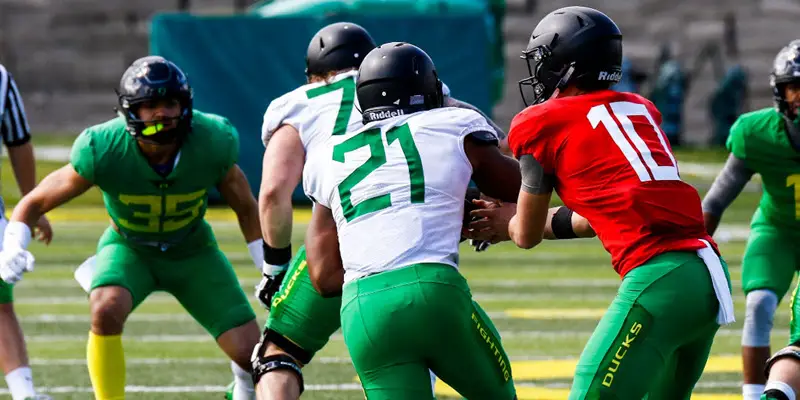When a football team scrimmages itself, it is a zero-sum game: if either the offense or defense has success, it automatically makes the other team look bad. For this scrimmage review, I will analyze why one team was successful rather than just say the offense scored a touchdown so they must be good or the defense gave up a touchdown so they must be bad.
Three matchups stood out throughout the scrimmage today:
First, there is the battle between senior wide receiver Darren Carrington II and true freshman defensive back Thomas Graham Jr. These guys got after it all day long. There were five or six deep balls along the sideline in which Carrington and Graham were one-on-one from the start of the play to the end. Justin Herbert threw some great passes that all ended up being 50/50 balls, meaning each player had a chance to make a play. This is what competing is all about.
I would say Graham had the edge over Carrington, with more pass breakups (PBU) than Carrington had catches. One play rose above the rest: it looked like Carrington had it in the end zone, but Graham was in his hip pocket and pried out the ball as Carrington was landing, breaking up what would have been a touchdown. Great ball skills and determination by Graham.
There was one play that stood out where Carrington won. The ball was on the defense’s 40-yard line. Carrington was one-on-one with Graham. Graham was in press coverage (look for my upcoming analysis article on this next month) and Carrington was running a fade (a “nine” route) down the sideline.
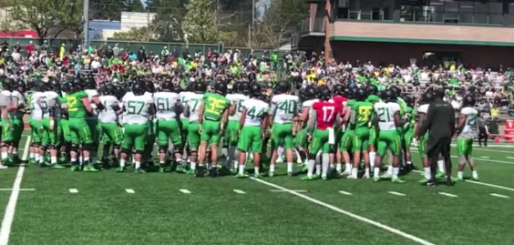
Team gathers before scrimmage.
Carrington got a free release off the line (meaning, Graham did not obstruct his path upfield), so Carrington was able to run past Graham down the field.
Thanks to Graham’s technique and athleticism, he was able to catch up just before the ball arrived, showing great recovery speed. But the ball was so well thrown, Carrington was able to finish the catch – just a finger-length away from Graham’s reaching arm – for a 40-yard touchdown.
It was a blast watching these two bring out the best in one another.
The second battle was between running back Royce Freeman and the interior of the Ducks’ run defense. Last year this would have been a laugher in favor of Freeman. This year it was the opposite. The defensive line and inside backers usually walled off and stopped Freeman on attempts between the tackles.
The defensive line of Jordan Scott, Henry Mondeaux and Elijah George played heavy (did not get moved) and stayed square and disciplined, leaving little room for Freeman to work. From there, linebackers Troy Dye and A.J. Hotchkins were stacking the talented back up for minimal to no gain for much of the scrimmage.
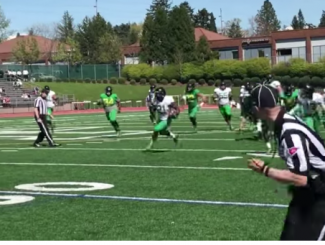
Royce Freeman gets to the edge and cuts upfield for a big run.
I was impressed with the improvement in this part of the run defense, since the Ducks gave up 38 rushing touchdowns last year. Good run defense starts with being tough up the middle.
The third battle was the outside run game. Freeman did not have success running up the middle, but he, the offensive line and wide receivers did have tremendous success running to the outside.
Several times the offense outflanked the edge defender (I’ll have a more in-depth article on this later this month) and Freeman ran wild in the open space. He looked great in the open field. Once he gets to the second level, he is a problem for all defenses due to his strength and size.
Oregon is NOT running a 3-4 defense?
My colleague at FishDuck.com, Coach Mike Morris, made an observation watching Colorado game film. The Ducks’ base defense is now a Nickel defense, and not a 3-4 after all, but a 3-3-5. This is a very different defense from what we believed was coming to Oregon.
Khalil Oliver and Fotu Leiato were 1st- and 2nd-string nickel backs yesterday and reported as “Duck” linebackers by GoDucks.com. The nickels “flip flop,” always lining up on the wide side of the field, while the other OLB (Jimmie Swain and Jonah Moi) also flip flop, lining up as a standup defensive end. So it looks like/is a “50 front,” but with 3-3-5 personnel.
My opinion is this is due to “matching,” meaning if the offense comes out with three receivers or more, the nickel defense personnel will be in the game.
Most teams on the schedule, with the exception of Stanford, run 3-WR-plus sets, so I expect the nickel personnel will be on the field the majority of the time to cover the extra receivers. This is a big reason why this year Dye was moved from outside to inside “Will” backer. In this position, he can stay on the field to cover tight ends and running backs when offenses go to more passing personnel. As a coach you do not want linebackers to cover receivers very often.
When Oregon runs an “even” 4-2 front on passing downs, they substitute an OLB as a pass-rushing DE, for the NT. (That will probably change with the addition of graduate transfer Scott Pagano.) Colorado also flipped their ILBs, making them a “Mike” and “Will” instead of left and right linebackers, and this will be interesting for all to observe in the Spring Game as well.
Starting to develop an identity …
The scrimmage, which consisted of “1st string vs 1st string, 2nd vs 2nd, etc.” opened with Herbert throwing a deep post route that Arion Springs intercepted. The pass was underthrown, and Springs showed great recovery, turning a potential big play for the offense into a big one for the defense.
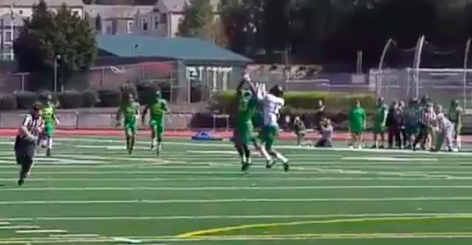
Arrion Springs intercepts first play of scrimmage.
The defensive sideline energy after the play was like “that is what we’re about now. Making plays.”
Other than that first throw, Herbert looked good. The snaps to start the scrimmage were a little erratic, which disrupted the offense’s timing. Once the snaps improved the rhythm of the passing game improved as well.
That being said, the pass rush did get home a couple of times, although it is hard to get a true feel for the effectiveness of the pass rush when the defense isn’t allowed to tackle the quarterback.
Play-action passing with Herbert and Freeman is going to be elite. Herbert found tight end Jacob Breeland several times streaking down the hashes after a run fake. There were a lot of play-action play calls.
One play that just seems unfair, as a defender, was when Herbert gave a shoulder fake on a hitch route, the defensive back bit hard, and the receiver was wide open for a touchdown. The fake was so quick and in the rhythm of the play – it was a great display of quarterbacking.
Another exciting and effective play was the screen pass to Freeman. The play call and timing were great, as they invited an aggressive defense to charge up field. A couple of times, Freeman slipped out of the backfield and ran wild in the secondary.
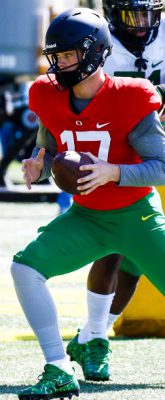
Braxton Burmeister
Coach Willie Taggart called a couple of the Toss Read plays that Coach Eric Boles wrote about. Taggart was the most upset I saw him all day when freshman quarterback Braxton Burmeister incorrectly kept the read on one of these. I could hear him yelling, “You have to read it! You have to read it!” – meaning Burmeister did not read the lineman properly and kept the ball instead of handing it off. Coach Eric Boles told me the South Florida quarterback might have kept it twice all season when reviewing the film from last year.
FishDuck.com Principal, Charles Fischer, and I talked after the practice. He was impressed with the progress Travis Jonsen has made since last fall. He said that he worries about any quarterback’s durability that is not “thick like Masoli,” so it was good to see Jonsen’s growth.
The defensive line played well, but they need depth, making Pagano’s transfer huge for the defense.
It was a great day to be a Duck and a Ducks fan, as both sides of the ball were competitive and eager to be playing. I credit Oregon for opening up the scrimmage to the public and credit the players and coaches for bringing a whole bunch of energy to the field making the scrimmage a great watch. That is why we love Ducks football.
Coach Ruskin Fiegenbaum
Beaverton, Oregon
Top Photo by Gary Breedlove
Related Articles:
Ruskin has been following the Ducks since the ’94 Rose Bowl. He graduated from the University of Oregon in 2007 and has been coaching football in the Portland-Metro area since 2008.

